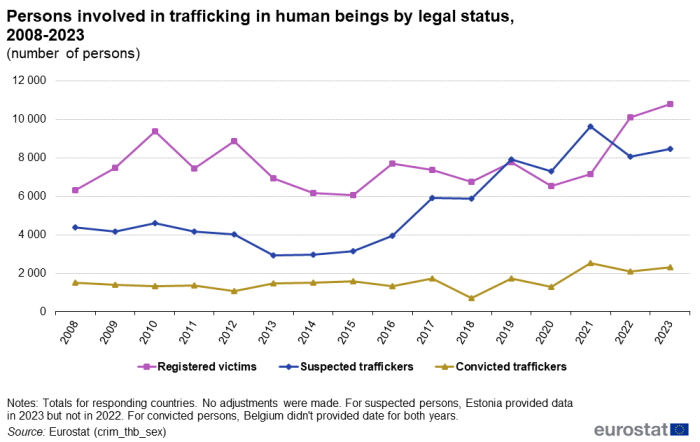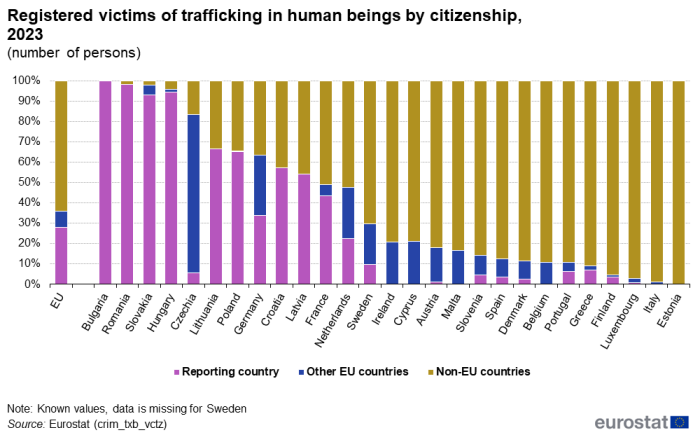Data extracted in March 2025
Planned article update: January 2026
Highlights
In 2023, the number of registered victims of trafficking in human beings in the EU was 10 793.
Nearly two-thirds (63%) of the registered victims of human trafficking were women or girls in 2023.
During the last 5 years, there was a notable increase in the number of registered victims trafficked for forced labour or services.

The statistics presented in this article are based on official figures for persons involved (registered victims, suspected traffickers and convicted traffickers) in trafficking in human beings in the European Union (EU) between 2008 and 2023.
Trafficking in human beings, as defined in Article 2 of the Directive 2011/36/EU, is a grave violation of human rights, a crime against the person, the goal of which is the exploitation of the person. Trafficking does not require the crossing of borders and can have many exploitative purposes.
Number of registered victims and of suspected and convicted traffickers
In 2023, 10 793 victims of human trafficking were registered in the EU, an increase of 6.9% compared with 2022 and the highest recorded value in the period 2008-2023 (Figure 1). In 2023, 14 out of 27 EU countries reported an increase when compared with 2022 in the number of registered victims. Several countries explained that it is partly reflected through increased attention of the authorities and agencies that fight against trafficking in human beings.
In 2023, the number of suspected traffickers was 8 471, compared with 8 064 in 2022, showing an increase of 5% (Figure 1). The number of convicted traffickers increased in the EU by 10.1% from 2 097 in 2022 to 2 309 in 2023, and the number of people convicted of trafficking in human beings increased in 15 EU countries (out of 26 that provided the data for both years).
Between 2008 and 2023 the number of suspected and convicted traffickers reached the highest level in 2021. Furthermore, the number of convicted persons remained much lower than the number of those suspected of trafficking in human beings (Figure 1). As some EU countries have not reported data on suspected and convicted traffickers for some years, the observed trend has to be interpreted with caution.

Source: Eurostat (crim_thb_sex)
63% of registered victims of trafficking are women or girls
In 2023, 63.3% of registered victims of trafficking in human beings in the EU were women or girls (Figure 2). The share of women and girls increased from the previous year (62.8% in 2022). The proportion of women among the traffickers is much lower compared with the proportion of men. In 2023, among the suspected traffickers, 24.2% were women (23.2% in 2022) and 23% of those convicted were also women (21.6% in 2022).

Source: Eurostat (crim_thb_sex)
24 registered victims of trafficking per one million inhabitants
In 2023, there were 24 registered victims of trafficking in human beings per one million inhabitants in the EU, compared with 23 in 2022 (Figure 3). In 2023, the highest rates in the EU were observed in Luxembourg (157), Greece (51), the Netherlands (49), Austria (47) and Sweden (45), while the lowest rates were observed in Croatia and Lithuania (5), and Czechia (2).
Higher rates could be linked to a greater capacity of the judiciary and social system to identify victims. This can be seen in Luxembourg, where previous efforts including a proactive attitude by labour inspectors who participated in mandatory training courses on human trafficking has contributed to the identification of more victims.

Source: Eurostat (crim_thb_sex)
One out of 4 of registered victims is a citizen of the reporting country
As the crime of trafficking does not require the crossing of borders, victims with the citizenship of the reporting country can return from abroad or be exploited in their own country. In 2023, for the EU as a whole, 28% of the registered victims came from the reporting country, 7.9% from other EU countries and 64.1% from non-EU countries (Figure 4).
At country level, the victims’ citizenship varies considerably: Bulgaria, Romania, Slovakia, Hungary, Croatia, Latvia, Lithuania, and Poland reported mostly victims from their own countries, while more than 80% of the registered victims in Austria, Malta, Slovenia, Spain, Denmark, Belgium, Portugal, Greece, Finland, Luxembourg, Italy, and Estonia came from non-EU countries.

Source: Eurostat (crim_thb_vctz)
The prevalence of labour exploitation is almost equal with sexual exploitation
Among the registered victims whose form of exploitation was reported, sexual exploitation was the predominant form of exploitation in 2023, at 43.8%, although the share of sexual exploitation gradually decreased over the period 2008-2023 (Figure 5).
There was a notable increase in the number of registered victims trafficked for forced labour or services. Between 2008 and 2018 the share of victims trafficked for forced labour and services stood between 14% and 21% and from 2019 onwards the share was between 28% and 41%. Organ removal and other exploitative purposes, including use for benefit fraud, criminal activities and forced begging, were at 20.2% in 2023.

Source: Eurostat (crim_thb_vexp)
Source data for tables and graphs
Data sources
Data sources include police and other law enforcement agencies, public prosecutors, law courts, prisons, relevant ministries and statistical offices. The national authorities are responsible for official figures that are sent to Eurostat and the United Nations Office on Drugs and Crime (UNODC). The number of persons reported as being involved in trafficking in human beings can vary widely across the EU, even relative to population size. This can be due to different approaches to reporting data in police, prosecutors and court systems, to different levels of transposition of the Directive across the EU Member States and different criminal justice responses to trafficking in human beings.
This article presents results based on official figures provided by national statistical offices and National Rapporteur or Equivalent Mechanisms on persons involved in trafficking in human beings from 2008 onwards. Non-governmental agencies, labour inspectors, social services, border guards, immigration services and other institutions are involved in reporting the number of victims according to national protocols for the detection of victims. The web database contains figures as reported (no adjustment). The totals for the EU include only countries which report the data. No adjustments or estimations are made for non-responding countries.
The crimes are classified in accordance with the ICCS (International Classification of Crime for Statistical Purposes). The counting methodologies for offences and persons should be applied. Countries' compliance with counting methodologies is explained in the general and countries metadata. National sources and compliance with statistical definitions are explained in the trafficking in human beings metadata.
Context
The statistics presented in this article are based on official figures for persons involved:
- registered victims who have been identified by the relevant formal authority or by other national and non-national authorities.
- suspected traffickers: persons brought into formal contact for a trafficking in human beings with the police/criminal justice system. Formal contact with the police and/or criminal justice system may include persons suspected, or arrested or cautioned, for a criminal offence, at the national level.
- convicted traffickers: persons found guilty for a trafficking in human beings by any legal body authorized to pronounce a conviction under national criminal law, whether or not the conviction is later upheld.
Directive 2011/36/EU on preventing and combating trafficking in human beings and protecting its victims (Anti-trafficking Directive) lays down, in Articles 19 and 20, requirements for EU Member States to gather and report on statistics on trafficking in human beings. Eurostat has been collecting and making available EU-wide data since 2008. This data collection has been carried out as a coordinated effort between the national rapporteurs and/or equivalent mechanisms for reporting statistics on trafficking in human beings and the European Commission (Eurostat). The data are unadjusted and published as they are reported by EU Member States.
Crime statistics are used by EU institutions, national authorities, media, politicians, organisations and the general public. Each state establishes its own criminal laws, defines crimes, legal proceedings and justice reactions, as well as specifications for official crime statistics (except for crimes covered by international or EU law). Typically, comparing crime statistics between countries is challenging due to different national criminal laws and different criminal justice systems.
However, it could also be argued that there are many similarities between European countries. This, combined with public and political interest, was the background for developing EU-wide crime statistics. Over the last decade, EU institutions, national authorities and the UN have cooperated to improve European crime statistics. A major quality improvement is to use a common classification of crimes.
Official crime statistics mainly reflect how the authorities register and handle cases. The figures are provided by national authorities such as the police, prosecutors, courts and prisons. Of those, police figures give the broadest picture, as they include recorded offences - whether or not they led to prosecution. Still, the police records do not measure the total occurrence of crime. Simply put, the total occurrence would be the reported crimes plus the unreported crimes, minus the incorrectly reported crimes.
